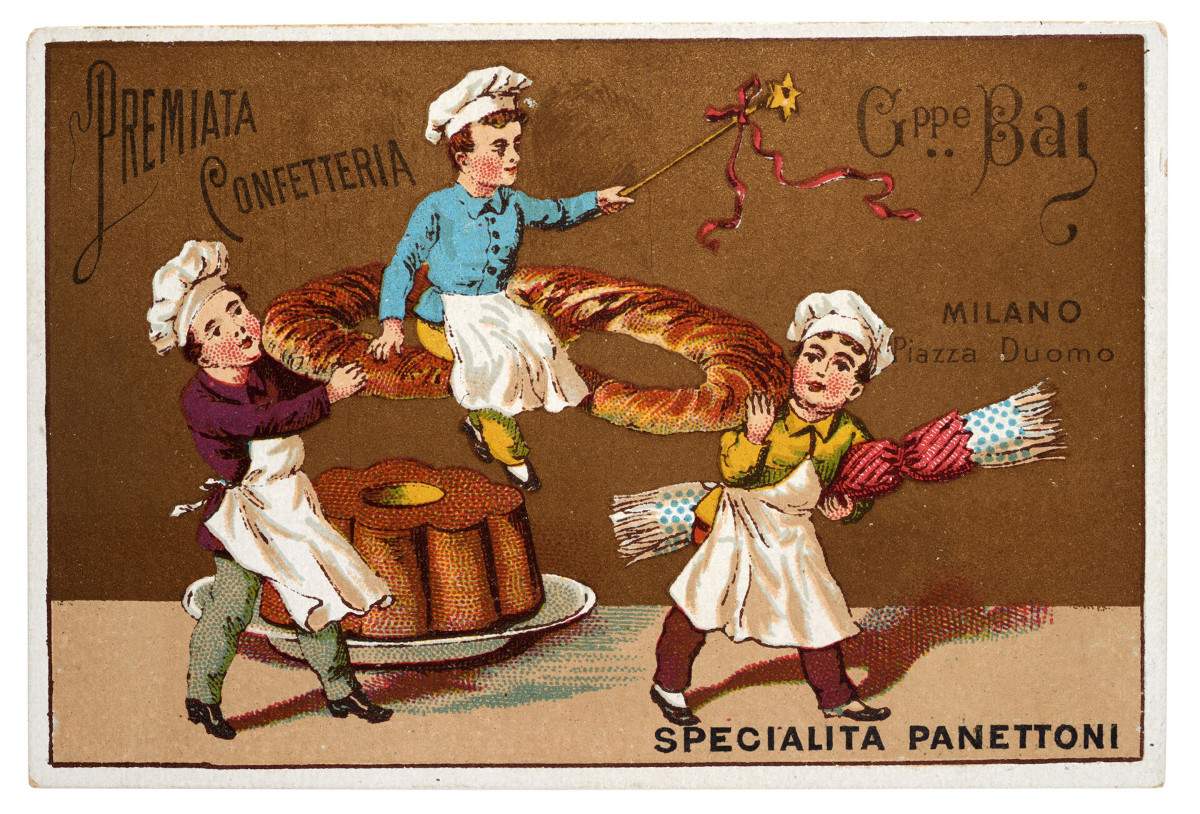Through Jan. 8, 2024, the m.a.x. museum in Chiasso, Switzerland, in the atrium, presents the dossier exhibition The Artistic Graphics of the Baj Firm, which aims to document the artistic graphics of the Baj Firm, a confectionery and panettone company known in both Italy and Switzerland.
The exhibition brings together a series of original vintage graphics of labels, window decals, the historical packaging of tin and cardboard boxes, as well as examples of Ditta Baj’s artistic advertisement.
The company was founded in the second half of the nineteenth century by Giuseppe Baj, who worked from a very young age in the family bakery, where panettone cakes had been made since time immemorial; documents dating from the late nineteenth century attest the start of the business to 1768. Giuseppe Baj participated in his twenties as a Garibaldi volunteer, in the Cacciatori delle Alpi, in the glorious campaigns for the Unification of Italy in 1859 and 1860. In 1872 the Baj Confetteria moved to Piazza del Duomo, at the same time starting a busy business producing and trading panettone, chocolate and other confectionery products, in a “hydraulic-powered and steam-powered factory.” Giuseppe Baj was honored in 1887 as the best panettone producer in Milan and was one of the very first to elevate panettone from the level of artisanal production and local diffusion to the production of high quantities, with consistent national and international diffusion and extensive advertising of the product in general.
The notoriety of Giuseppe Baj’s business can also be deduced from the slogan that resounded in the heads of all Milanese in the nineteenth and twentieth centuries: “When in Milan there was not yet the tramvaj already enjoyed the Panettone Baj.”
Panettone Baj continued to be starred in the 1930s by some of Giuseppe’s sons, including Alfredo, grandfather of Cesare Baj, but at a level far removed from the splendor of the past, until it died out toward the end of the decade, at the outbreak of World War II. Since the postwar period, the Milanese cake was able to return to offer moments of happiness in homes around the world, but it took until 2023 to see the Baj Panettone again.
“In the first decades of the twentieth century,” says Cesare Baj, great-grandson of the founder, as well as a popularizer of science and aviator, “connoted by the great progress of science and technology, the strong cosmopolitan spirit and the bursting of the first literary and artistic avant-gardes, it is fascinating to highlight the subtle link of the Baj panettone with the aeropoet Filippo Tommaso Marinetti, to whom I also feel linked as an aviator, and with Futurism in particular. It should be remembered that in the very early twentieth century the skies ’became populated with flying machines,’ which are also present in the period graphics of Baj panettone.”
The head office was in Milan, Via Santa Radegonda, with branches in Chiasso and Genoa (until World War I).
The Baj Confetteria was frequented by artists, musicians and men of letters, who mentioned or described it in many of their works. It had as a regular customer the founder of Futurism, Filippo Tommaso Marinetti, who at Christmas sent friends and collaborators a Baj Panettone with copies of his magazine Poesia, nowadays almost unobtainable cult objects. Marinetti, in his memoirs, speaks of wanting to build a “giant panettone of goodness and quick digestion, destined to dispel the prehistoric pastry, six meters in diameter and two meters high.” Afternoons in Baj Confetteria were cheered by music played on the piano by Teresa, Giuseppe’s wife. The Baj Confetteria, with a few surrounding buildings, including Caffè Cova, had a curious record: electric lighting. In fact, in 1883, right on Via Santa Radegonda, the first electrothermal power plant in Europe went into operation, the second in the world after the one in Chicago, built by the engineer Colombo to an Edison design. Thus it was that from then on Giuseppe Baj’s clientele was greeted by the light of electric bulbs.
More than a century after the heyday of the Baj Panettone and after several decades of oblivion, two direct great-grandchildren of Giuseppe Baj, Cesare, with a background as a publisher, designer of scientific toys and aviator, and Tomaso, his son, a communication designer, felt an ancestral, irresistible pull. Looking back at the memorabilia of their ancestor’s confectionery production, the beautiful réclames dating back nearly a century and a half earlier, the sturdy postal shipping packages of the time, the idyllic photographs showing Giuseppe and Teresa’s children amid the panettoni, in poses meant to advertise the family’s products, the two great-grandchildren felt a sort of pull toward this area of traditional entrepreneurship. Thus was born the idea of restarting a 21st-century version of Baj Panettone production, combining the merits of a two-and-a-half-century-old recipe with the most modern production techniques. To take care of all aspects of production, some of the top experts in the confectionery sector were involved, people with decades of activity behind them precisely in the field of baked goods, able to manage at the highest levels the choice of ingredients and quality control, while respecting the original recipe.
For info: www.centroculturalechiasso.ch
Hours: Tuesday through Sunday from 10 a.m. to noon and 2 to 6 p.m. Free admission.
 |
| In Chiasso, a dossier exhibition on the artistic graphics of the Baj confectionery and panettone company |
Warning: the translation into English of the original Italian article was created using automatic tools. We undertake to review all articles, but we do not guarantee the total absence of inaccuracies in the translation due to the program. You can find the original by clicking on the ITA button. If you find any mistake,please contact us.